The ‘Queens’ Giving a Middle Finger to Sexism—and Changing Wildlife TV
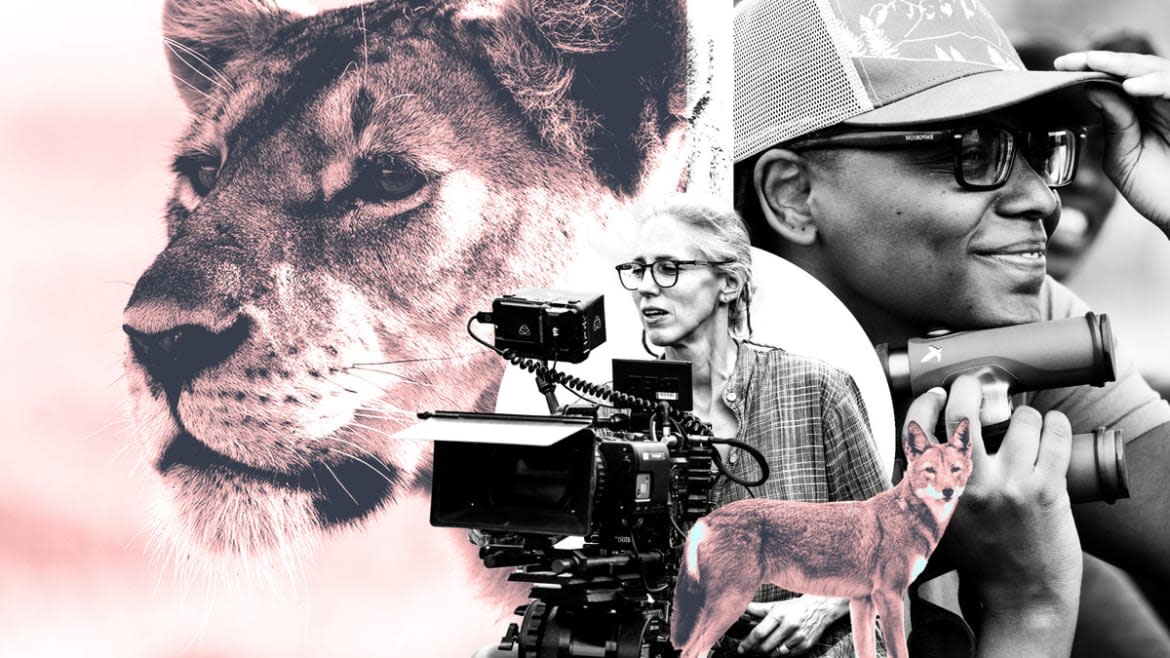
- Oops!Something went wrong.Please try again later.
NGORONGORO CRATER, Tanzania—Of the scene’s many horrors, it’s the sound that haunts the most.
The Ngorongoro Crater in Tanzania, by day, can seem like a sanctuary, a sprawling volcanic caldera whose towering crater walls create a distinctly protected habitat in the Serengeti. As the sun pierces through the billowing clouds that dot the sky, the crater resembles a majestic paradise, where elephants, zebras, lions, wildebeest, hyenas, and flamingos seem to perform a breathtaking, daily live version of “The Circle of Life.” But even within this wildlife utopia there’s the constant reminder of the true nature of the African plains: This is a savage kingdom.
For months, Kenyan filmmaker Faith Musembi, a producer and director on National Geographic and Disney+’s acclaimed new docuseries Queens, had been tracking a lioness who had been living with her sisters and five cubs in one of the crater’s most thriving dens. A lone male had been circling for days on a nefarious mission: He planned to kill the mother’s cubs, so that he could impregnate her and replace them with his own, becoming the den’s alpha male.
Hoping to starve the mother out of safety so he could get to the cubs, he spent days and nights stalking the den. She knew her only recourse would be to move the cubs, and, with the help of her sisters, who distracted the male, sprung into action. She was only able to move the cubs one at a time, leaving the rest of the siblings unguarded. The vulnerable cubs, left alone, began crying out for their mother, reminding the male of the task at hand.
What follows is a vicious, visceral sequence. The male reaches the unattended cubs. When the mother catches on, she bounds back to the den as quickly as she can run, roaring with despair and purpose. She and her sisters violently battle the male, snarling, thrashing, and clawing. It’s a brutal clash soundtracked by a more unsettling cacophony of fight sounds and the wails of a mother’s desperation.
“People always talk about a fierce mother lion, comparing a [human] mom to a fierce lioness with her cubs, and I saw that play out that night,” Musembi told The Daily Beast’s Obsessed after a morning of safari, where she toured us through several of Queens’ shooting locations in Tanzania. “She was in a dried-out ravine, and the sounds were just verberating off the walls.”
As the struggle unfolded, Musembi found herself crying: “I was moved to tears because of how this mom was fighting. I think back to that sound. At one point, she sounded like she was sobbing, because she was roaring and growling, and then she would stop to catch her breath. But she was still making those [crying] sounds, so it sounded like she was sobbing.”
It’s perhaps a spoiler, though also the inevitable reality of the natural world, to say there are casualties. Musembi, and the Queens premiere episode, “African Queens,” continued to track the mother and the den, observing the moving and truly surprising way the lions cope with the event. “As much as we’d love to separate ourselves and say, ‘I’m an observer... I don’t feel…’ No, you feel,” Musembi said. “We’ve been following these animals for a while. But I wouldn’t change it for anything.”
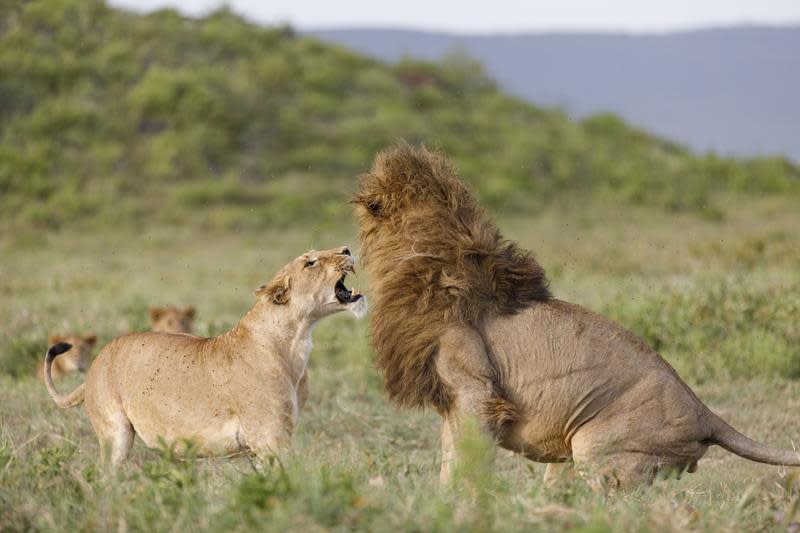
A lioness shows aggression towards the pride male
The astounding sequence is unlike anything that’s been seen before in a wildlife program. That’s partly a feat of technology: The state-of-the-art infrared cameras used to film the lions in the pitch black of night were able to capture the details of the animals and the fight with revolutionary clarity. But everything about the production and storytelling of Queens is historic.
The series marks the first time that any wildlife series—from NatGeo, the BBC, Discovery, Netflix …anywhere—has featured a nearly all-female leadership behind the scenes, whether that be in production, editing, tracking the animals, or filming. Included in that accomplishment is a recruitment of local, rising female filmmakers from the areas where Queens shot. Musembi is the first Black Kenyan female director of a wildlife film—her mom grew up 50 kilometers from where one of the episodes of Queens filmed—while Erica Rugabandana, a filmmaker and mother just starting out her career, was selected as a mentee, becoming the first Tanzanian wildlife camerawoman to work on a series of this scale.
The groundbreaking project with its female-led mission required an unprecedented investment in delivering opportunity and training for women who had not worked in the field in this way before. That’s not to mention the necessary lighting of dynamite sticks to explode the decades of white, privileged, Western, and male-dominated culture that had become the Bible for wildlife filmmaking. In many ways, then, the Queens experiment is as sacrilege as it is innovative. The series is a first in yet another way: Each episode focuses on the matriarchs of the animal kingdom, an angle that had, almost unfathomably, never been done before—because women had never been in the leadership position.
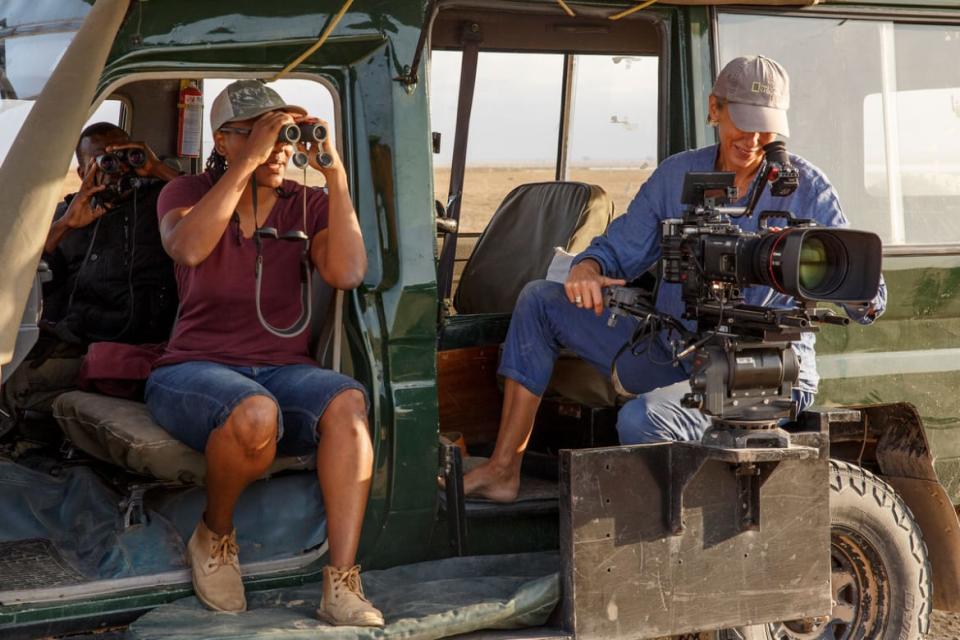
Queens director Faith Musembi and director of photography Sophie Darlington film elephants from the vehicle.
At a time in television and film when inclusivity and agency in storytelling is one of the industry’s most vital conversations—and when equity and opportunity for marginalized voices in any field is both urgent and embarrassingly lacking—Queens is both a movement for the future as well as a reflection of the present. As Angela Bassett narrates in the opening moments of the series: “The wildest places on our planet have always been home to powerful leaders. But now a new hero is rising. Fierce. Smart. Resilient. And female.”
All hail the queens
Each episode of Queens features a matriarch’s stunning resilience, tenderness, or, even, ruthlessness. But the story of Queens is as much about how the series got made as it is about the episodes themselves—all of which are now available to stream on Disney+ and Hulu.
About four years ago, National Geographic’s senior vice president of development and production, Janet Han Vissering, and veteran wildlife filmmaker Vanessa Berlowitz had a shocking realization during one of their random meetings: There had never been a series that focused exclusively on the female leaders of the animal world, on whose shoulders and hinds the responsibility of keeping their families—and, sometimes, entire species—alive fell.
Berlowitz had spent 25 years working her way up the chain at the BBC’s Natural History Unit, collaborating on legendary projects like Planet Earth, Frozen Planet, and Planet Earth 2. Throughout her career, she had traveled with Sir David Attenborough to the North and South Pole, and lived for two-and-a-half years with her husband and young son in the bush in Botswana. But her entire time at the BBC, she often found she was the only woman around. Whether out in the field or, as she rose up the ranks, in the corporate suites, it was all men, fostering a culture that was especially inhospitable to women in the field who were also mothers.
Oscars Review: Jimmy Kimmel Hosted the Best Show in Years
“A lot of first time moms drop out [of the industry],” Berlowitz said. “I think I was the first one at the senior level to keep going in wildlife with kids, which was difficult at the BBC.” She co-founded Wildstar Films in 2018, with the goal that taking charge herself would allow her to platform other women whose talents are dismissed because of the industry’s institutionalized sexism. She and Vissering hatched an idea: What if NatGeo and Wildstar partnered for this groundbreaking show about matriarchs—and what if they staffed it with an all-female team?
It turned out not to be that simple.
Berlowitz estimated that, when Queens began, there were only five female wildlife filmmakers in the world with the expertise to man shoots as ambitious as the series would require; she hired two of them, Sophie Darlington and Justine Evans. Wildstar and NatGeo would then have to commit to finding new female talent to train or recruit mothers who had left the field, like showrunner Chloe Sarosh, with the promise that, this time, they’d be supported.
And for too long, Berlowitz thought, the lion’s share of wildlife filmmaking was based and produced by Western crews in Bristol, England, who would parachute in and out of filming locations. Queens would invest in working with people from the local communities, like Musembi and Rugabandana, whose on-the-ground experience would add a fresh perspective to the storytelling.

Queens director Faith Musembi and director of photography Sophie Darlington film elephants from the vehicle.
“This is the first series that looks at female power in the natural world, and you can’t help but relate that to your own experience as a female leader, now, who has tried to exert power in the natural history filming world,” Berlowitz said. “I haven’t always had that power. And I haven’t always had that voice. I guess the reason I was so determined to try and change the industry was I thought, Oh my God, I’m a white woman that’s relatively privileged, that has come through from the system, that goes to these countries and acquires content and then brings it back. Imagine how frustrating that must be to be proud of that place? How on earth would people like Faith or Erica gain access to have a voice in that story?”
“For many years, I felt very isolated and not listened to,” she added. “And it’s taken a while. And I’m very, very grateful that I'm now in a position to pay that forward and give other women the opportunity.”
On the ground in Tanzania
I spent a week traveling through Tanzania with Berlowitz and Musembi, from Arusha to Serengeti National Park to the Ngorongoro Crater, before reuniting with them in Los Angeles two months later at the Television Critics Association conference—where I’d also meet Darlington, Evans, and Sarosh. It was the trip of dreams, discussing the invigorating challenges of getting Queens made while also on safari with them. The pair served as pseudo guides, pointing out animal behaviors and sharing filming stories as we’d encounter two herds of elephants converging and crossing in front of us. The next day, we met a veritable clown car of more than a dozen lions and their cubs emerging for a stroll past our jeep—a miracle sighting.
There was a once-in-a-lifetime element to the notion of being led through safari by actual National Geographic filmmakers. I won’t soon forget Musembi narrating unusual, borderline slapstick behavior of two young lions playing with each other while trying to climb a tree, or Berlowitz’s fervent defense of hyenas against their reputation for being the plains’ wicked, sniveling villains. Being in the field with these women as they recounted their war stories—be it run-ins with animals or the even more precarious ones with the old white men in their field—detonated the revelation of how a project like Queens could change the industry. Moreover, it illuminated how their experience weathering the previous storm of bureaucratic, privileged bullshit will revolutionize storytelling and galvanize a whole new audience to the genre.
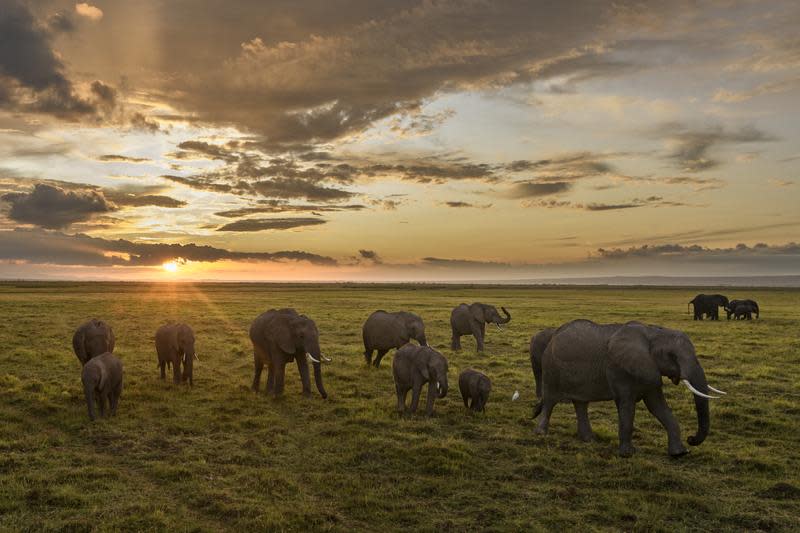
A herd of African elephants walks at sunset across the plains of Africa.
Berlowitz’s pride in pulling off the female-led production elements of Queens—a strong cocktail mixed with relief and a bit of surprise—is palpable. So too is her exasperation over the decades of being the only woman in a room, watching her colleagues leave because of the workplace culture, and, even as she ascended to leadership positions, feeling diminished and alone. Each story she told about her past, her watershed experience producing Queens, and appreciation the wildlife as we passed them on safari came out like a rally cry: a purpose finally coming to fruition and potential for the future unleashed.
Musembi exudes gratitude and enthusiasm, nurtured by her profound experience in the field shooting the show and amplified by her knowledge that this was a chance she thought never was coming her way. Because so many wildlife productions are based in England and fly, as she said, “British white women” in and out of countries for filming, she assumed she’d never be able to break into the industry as a Kenyan, unless she moved to Europe. Now, she’s at the forefront of National Geographic’s marketing and press for a show she produced and directed.
Of course, the proof of concept for Queens’s big swing is in the series itself.
“When it comes to natural history filmmaking, there’s a focus that we tend to have when we’re filming any species. You're going for the big moments, the vicious fights and all of that, which is very exciting and an important part of the storytelling,” Musembi said. “But I found there was freedom [on Queens] to lean into the tender moments.”
There’s an undeniable emotion pulsing through the episodes, which Berlowitz owes to the filmmakers eschewing traditional direction to “grab the shot and go” and instead linger with the animals. As intense as that mother’s fight for the lives of her cubs is in the premiere, the quieter sequences that unfold after are as captivating. “Savanna Queens,” an episode Musembi worked on about a family of elephants, contains sequences with the dramatic stakes of a proper blockbuster film, yet also several moments of serenity that sneak up on you, catapulting your heart to your throat.
‘A Real Bug’s Life’ Is a Live-Action Version of a Pixar Movie—And Could Change Minds
During Queens’ press conference in Los Angeles, a roomful of journalists and critics had screened the series. Everyone at NatGeo made it very clear that this is one of the most important series they’ve made. I asked the panel, given their experiences in the past at the male-dominated, antiquated places like the BBC—and given the tangible enthusiasm for the Queens now—if they had anything to say to the people from those networks after all those years coming up in the industry.
“Wow,” Berlowitz said, throwing her head back in delight. She’d later thank me for asking the “bomb of the question.” Everyone on stage seemed tickled at the idea of throwing their former colleagues under the bus, but resisted for something way classier: a celebration of what they’ve accomplished with Queens.
Because of their efforts, there’s a next generation of female filmmakers. The staff at Wildstar Films is now nearly 70 percent female—unheard of in the industry—and the Wildstar Academy is committed to training and financing women to go on the company’s shoots and learn on the job. And it’s finally a production company that’s hospitable to and encouraging of working mothers. Members of the production team had seven babies over the course of shooting Queens, and it never hurt their careers. “There were babies being passed from one person to another,” Berlowitz said. “Someone on the phone going, ‘I’ve got to call Africa. There’s a crisis, there's a war breaking out. Here, take my baby.”
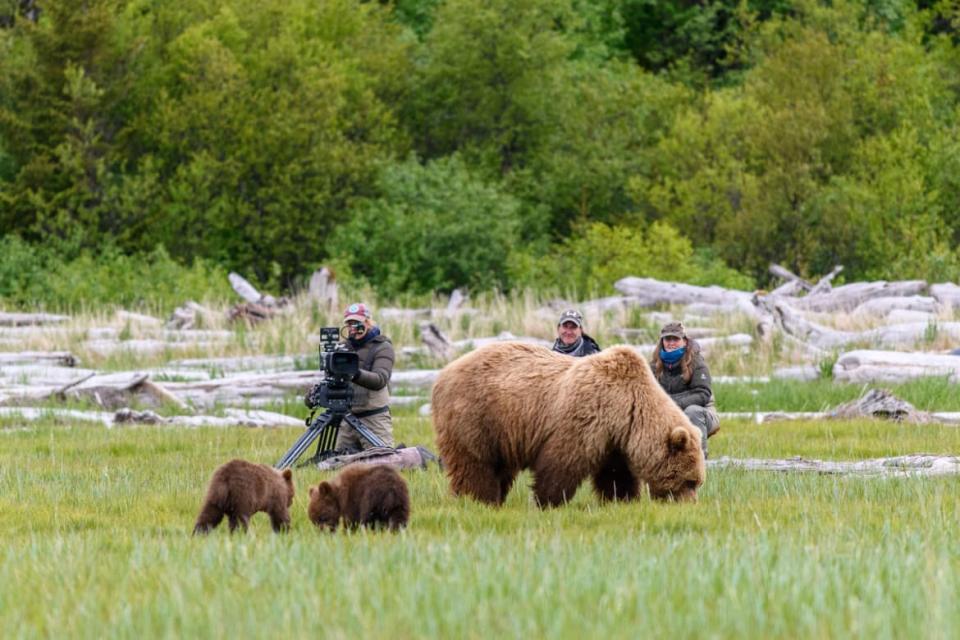
Queens cinematographer and mentee Erin Ranney films a bear and her cubs in Alaska.
“When we started making this production—I’m not saying this is from the BBC,” Sarosh told journalists, grinning. “I’m not casting aspersions like that. I wouldn't dare… But someone in our industry said, ‘Oh, Queens, that series the girls are making. And, obviously, all our hackles went up. Vanessa and I knew at that moment that not only did we have to make a great series, we had to make something that was better. And to sit here four years later with all these amazing women and go, ‘Well, just look at the series those girls made,’ feels really good and really important.”
The Academy Awards just took place this week, with its tribute to the industry-upending success of Barbie capping off a year-long discourse over whether old-guard organizations will accept a film “for women.” I flashed back to a lunch I had with Berlowitz in the Serengeti, where we talked about comparisons some could make about Queens’ mission to Greta Gerwig’s film.
“I would be thrilled if we could get into popular culture and make as much of a splash as the Barbie movie has,” she said. “I think that’s an amazing skill to be able to popularize, engage, entertain, but also have messaging in that if you want it, open to hear it. And that if we could achieve that would be phenomenal. So yeah, let’s be the Barbie of natural history. I’ll take that.”
Get the Daily Beast's biggest scoops and scandals delivered right to your inbox. Sign up now.
Stay informed and gain unlimited access to the Daily Beast's unmatched reporting. Subscribe now.

